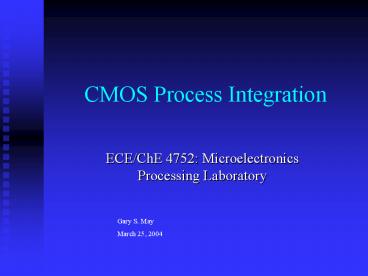CMOS Process Integration - PowerPoint PPT Presentation
1 / 18
Title:
CMOS Process Integration
Description:
CMOS Process Integration ECE/ChE 4752: Microelectronics Processing Laboratory Gary S. May March 25, 2004 Outline Introduction MOSFET Fabrication CMOS Technology Well ... – PowerPoint PPT presentation
Number of Views:295
Avg rating:3.0/5.0
Title: CMOS Process Integration
1
CMOS Process Integration
- ECE/ChE 4752 Microelectronics Processing
Laboratory
Gary S. May March 25, 2004
2
Outline
- Introduction
- MOSFET Fabrication
- CMOS Technology
- Well Formation
- Advanced Isolation
3
MOSFET
- MOSFET Metal-Oxide-Semiconductor Field-Effect
Transistor - At present, the MOSFET is the dominant device in
GSI circuits because it can be scaled to smaller
dimensions than other types of devices. - The dominant technology for MOSFET is CMOS
(complementary MOSFET), in which both n-channel
and p-channel devices are provided on the same
chip. - CMOS technology has the lowest power consumption
of all IC technology.
4
MOSFET Scaling
- In 1970s, gate length was 7.5 mm and device area
was 6000 mm2. - For present-day MOSFETs, the gate length is lt
0.10 mm.
5
Outline
- Introduction
- MOSFET Fabrication
- CMOS Technology
- Well Formation
- Advanced Isolation
6
n-Channel MOSFET
7
Process Sequence
- Start w/ p-type, lightly doped (1015 cm3),
lt100gt-oriented Si. - Form oxide isolation region (a).
- Define active area with photoresist mask and
boron chanstop layer implanted through
nitride-oxide layer (b). - Grow gate oxide (lt 10 nm) and adjust threshold
voltage by implanting B ions (enhancement-mode
device) (c). - Form gate by depositing doped polysilicon.
Pattern gate in source and drain regions (d).
8
Process Sequence (cont.)
- Implant arsenic (30 keV, 5 1015 cm2) to form
source and drain (a). - P-glass is deposited and flowed (b).
- Contact windows defined and etched in P-glass. Al
is deposited and patterned (c). - Top view of completed MOSFET (d).
9
Outline
- Introduction
- MOSFET Fabrication
- CMOS Technology
- Well Formation
- Advanced Isolation
10
CMOS Inverter Schematic
- Gate of upper PMOS device connected to the gate
of lower NMOS device. - Functions as a digital switch
- Low power consumption ( nW) is most attractive
feature
11
CMOS Inverter Layout
12
CMOS Processing
- p-well is implanted and driven into n-substrate
(p-type dopant concentration must be high enough
to overcompensate the n-substrate background
doping). - Subsequent processes for n-channel MOSFET in
p-well are identical to nMOSFET. - For p-channel MOSFET, B ions are implanted into
n-substrate to form source and drain - Because of p-well and steps needed for p-FET, the
number of steps in CMOS fabrication is double
that to make NMOS.
13
Outline
- Introduction
- MOSFET Fabrication
- CMOS Technology
- Well Formation
- Advanced Isolation
14
Well Types
- Single well discussed previously
- Twin well
- p-well and n-well side-by-side on lightly doped
substrate - Disadvantage needs high temperature processing
(above 1050 oC) and a long diffusion time (gt8
hours) to achieve the required well depth of 2
3 mm - Retrograde
- To reduce process temperature and time,
high-energy implantation is used - The profile of the well in this case can have a
peak at a certain depth in the silicon substrate.
15
Retrograde Wells
- Advantages
- Reduced lateral diffusion and increase the device
density. - Lower well resistivity
- Chanstop can be formed at the same time as well
implantation
16
Outline
- Introduction
- MOSFET Fabrication
- CMOS Technology
- Well Formation
- Advanced Isolation
17
Conventional Isolation
- Conventional MOS isolation process has
disadvantages for deep-submicron (lt 0.25 mm)
fabrication - High-temperature and long oxidation time result
in encroachment of chanstop implantation to the
active region, causing a threshold voltage shift.
- Area of the active region is reduced because of
lateral oxidation - Field oxide thickness is significantly less than
that grown in wider spacings - Trench isolation technology can avoid these
problems.
18
Shallow Trench Isolation
- (a) Patterning
- (b) Trench area etched
- (c) Trench re-filled with oxide
- (d) Chemical-mechanical polishing removes the
oxide on the nitride to get a flat surface































